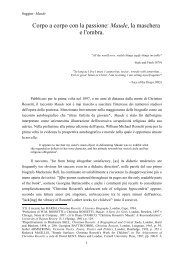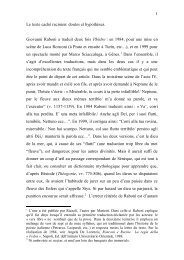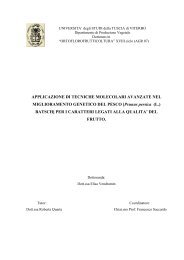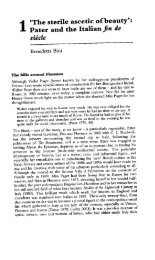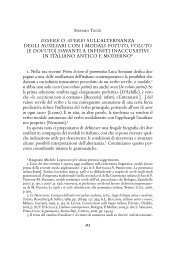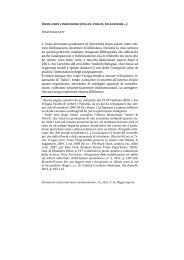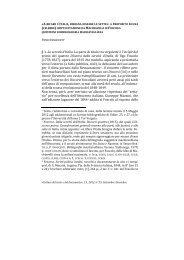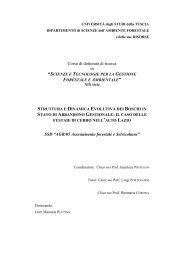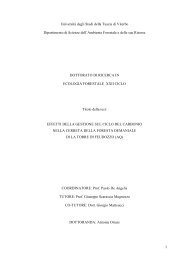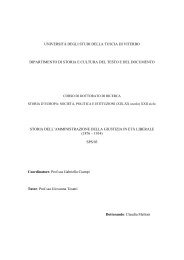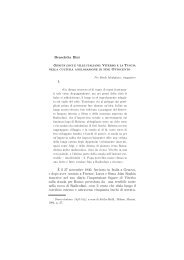drivers of soil respiration of root and microbial ... - Unitus DSpace
drivers of soil respiration of root and microbial ... - Unitus DSpace
drivers of soil respiration of root and microbial ... - Unitus DSpace
Create successful ePaper yourself
Turn your PDF publications into a flip-book with our unique Google optimized e-Paper software.
component, expressing a total <strong>soil</strong> <strong>respiration</strong> as a sum <strong>of</strong> <strong>root</strong> <strong>and</strong> <strong>microbial</strong>-derived sources,<br />
linearly dependent on <strong>root</strong> density <strong>and</strong> <strong>soil</strong> C content respectively.<br />
6.4.4. General comparison <strong>of</strong> three partitioning methods<br />
162<br />
After the discussion <strong>of</strong> all the particularities <strong>and</strong> shortcoming <strong>of</strong> the partitioning techniques<br />
applied in this study it is possible to compare the results obtained by the methods.<br />
The main positive observation is that mesh exclusion <strong>and</strong> combined SIR techniques, so<br />
different in its theoretical <strong>and</strong> methodological basis, showed quite similar results both in the<br />
magnitude <strong>of</strong> <strong>soil</strong> <strong>respiration</strong> fluxes almost for all the measurement days <strong>and</strong> in its seasonal<br />
variation patterns. Actually we expected to observe a higher <strong>microbial</strong>-derived <strong>respiration</strong> with<br />
combined SIR, as it allows an additional separation <strong>of</strong> <strong>root</strong> <strong>and</strong> rhizo<strong>microbial</strong> <strong>respiration</strong><br />
components. The difference between <strong>microbial</strong> <strong>respiration</strong>s, obtained from two techniques could be<br />
used as an estimate <strong>of</strong> the rhizo<strong>microbial</strong> component <strong>of</strong> <strong>soil</strong> <strong>respiration</strong>. However, having the<br />
different sources <strong>of</strong> the mistake, both methods result in the systematic overestimation <strong>of</strong> <strong>microbial</strong><br />
<strong>respiration</strong> component. The magnitude <strong>of</strong> this error is uncertain, which limits the reliability <strong>of</strong> such<br />
calculation <strong>of</strong> rhizo<strong>microbial</strong> <strong>respiration</strong>.<br />
The results obtained by mesh exclusion <strong>and</strong> regression analyses technique in 2008 differed<br />
significantly both in the magnitude <strong>of</strong> the <strong>respiration</strong> fluxes <strong>and</strong> in the seasonal patterns <strong>of</strong> relative<br />
contribution <strong>of</strong> single components to total CO2 efflux. Regression technique, given the most<br />
uncertain results, during the whole period <strong>of</strong> measurements was overestimating the <strong>root</strong>-derived<br />
<strong>respiration</strong> in confront with mesh exclusion method, sometimes calculating the <strong>root</strong> contribution as<br />
a 100% to total CO2 efflux from <strong>soil</strong>. To overcome all the uncertainties, which were mainly<br />
associated with the particularities <strong>of</strong> the grassl<strong>and</strong> communities the method requires further<br />
development <strong>and</strong> st<strong>and</strong>ardization.<br />
Summarizing, the comparison <strong>of</strong> methodologies in <strong>soil</strong> CO2 efflux partitioning techniques<br />
showed generally good agreement, there are numerous assumptions masked within these results,<br />
<strong>and</strong> we have tried to indicate where potential biases arise <strong>and</strong> corrections are needed.




